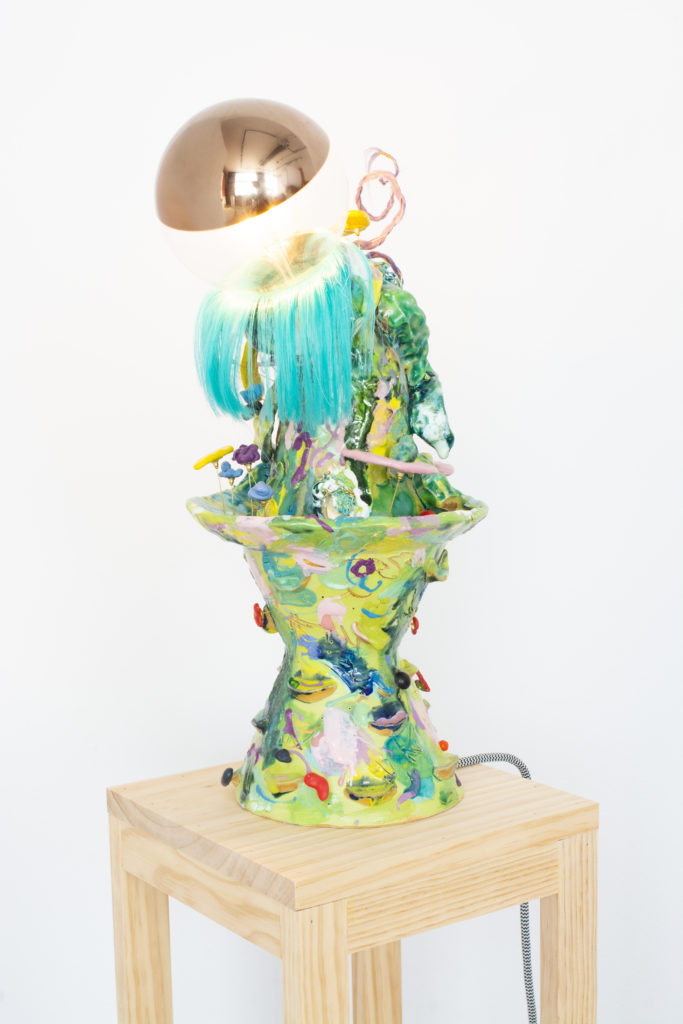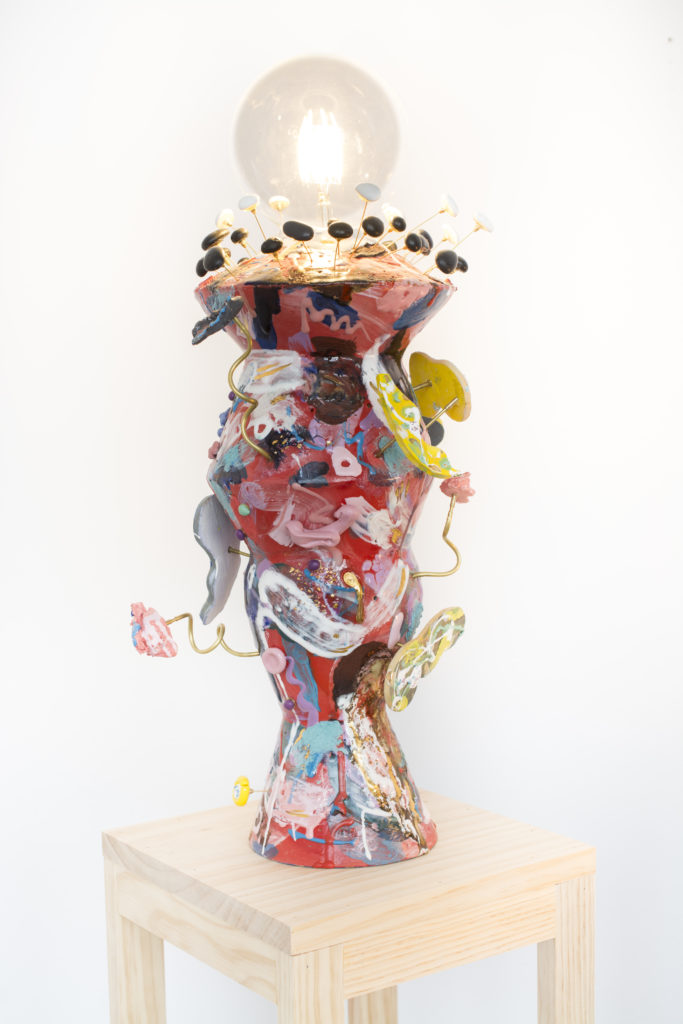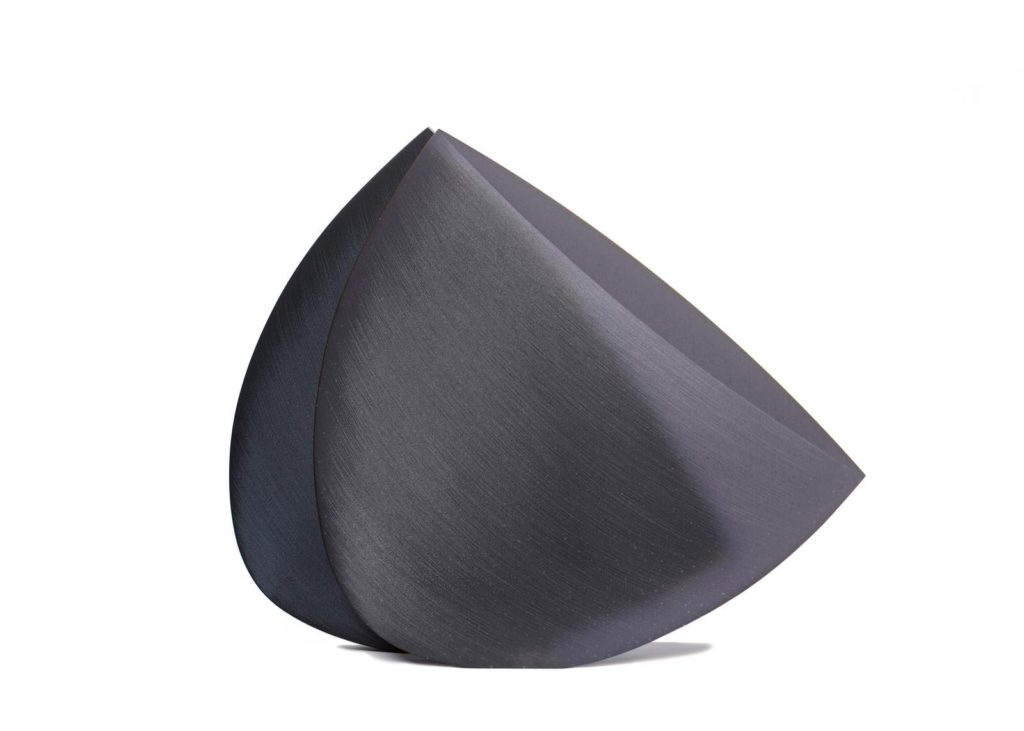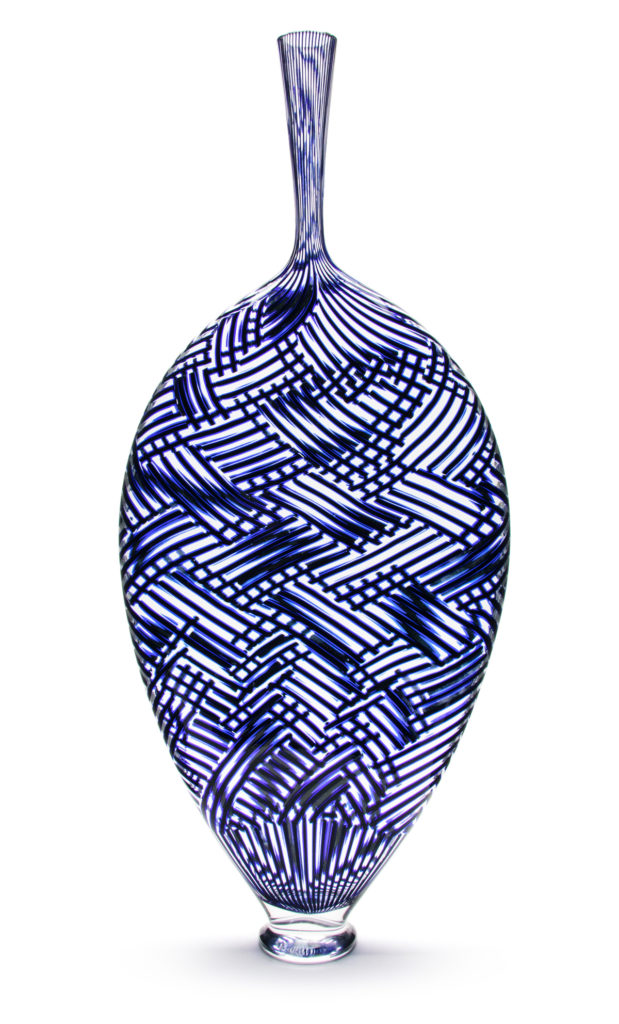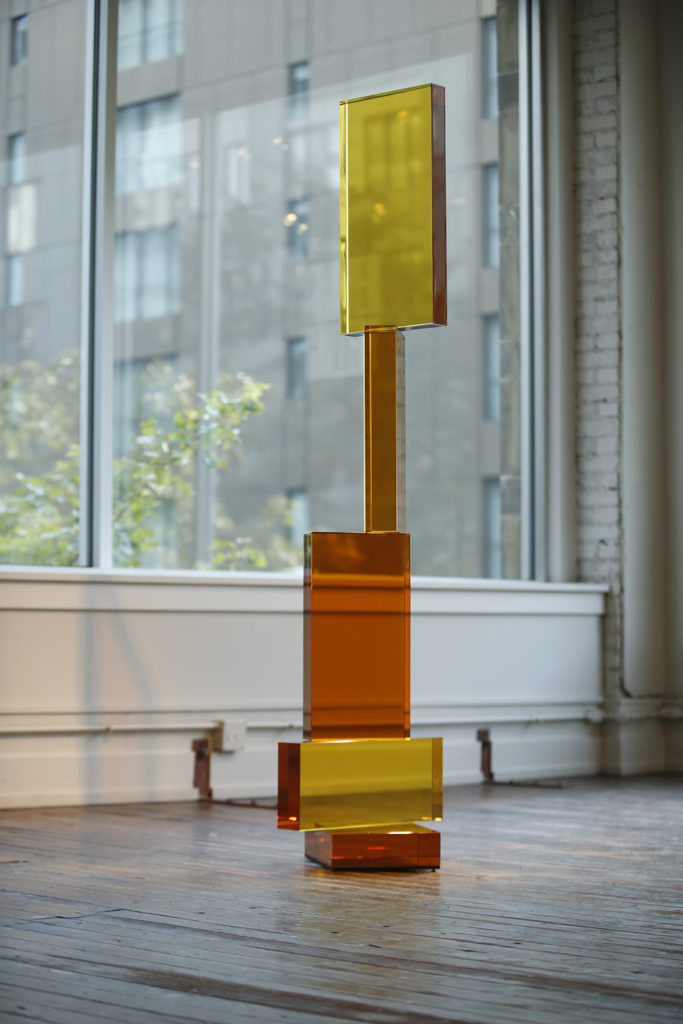Intersect Chicago/SOFA

-
About
Ling Chun - view profile
I have a drive, a lust and greed for color.
My ceramic forms are “playgrounds for glaze,” and I like to challenge the rules and roles of ceramics by disassociating the material from its stereotypical or culturally accepted uses. Removing still-hot pieces from the kiln, I apply liquid glazes to the surface creating a sizzling sound and a haze of steam until the glaze sticks. It is an intuitive process that emerges through multiple firings and layers of glaze. The work is born of the spontaneous dripping, sliding, running, climbing and crawling that occurs; the movement of the material is my medium.
The use of hair—which I see as a metamorphosis of the clay—serves as an extension of the ceramic process and also transgresses the permanence of clay, resetting the boundaries of ceramics reflected by cultural standards. My work also addresses my transitional stage between multiple cultures and languages through the complex layering of materials onto my ceramic sculptures. I believe contemporary ceramics will serve as a latter-day artifact of our current acknowledgment of cultural identity. It is a material strongly connected with history but never limited just to its heritage—a new age of ceramics will be one where style is no longer restricted to the old forms.
Ultimately, I desire to invite others into my side of the spectrum and to learn and study about how ceramics is more than just clay.
-
Mel Douglas
- view profile
Mel Douglas is one of the most celebrated artists working in glass today. Douglas’s refined and detailed work employs a minimalist aesthetic along with considered mark-making to engage a dialogue of how line and form can define and defy our understanding of space and volume. Douglas’ work explores the potential, versatility, and flexibility of glass as a material for drawing, and with it, expands our view of glass as a sculptural medium.
In Douglas’s words, “objects and drawings are often thought of as two separate entities. my pieces explore and interweave the creative possibilities of this liminal space, where the form is not just a support for drawing; but a three-dimensional drawing itself. Using the unique qualities of the material and the rich potential of mark-making on and with glass, I am using line as a way to inform, define and enable dimensional space”.
Mel Douglas has worked as an independent studio artist since graduating from the Canberra School of Art, Australian National University, in 2000. In 2020 Douglas was awarded a Ph.d. for her practice-lead research investigating how we can understand studio glass through the aesthetics of drawing. In addition to winning the 2020 and 2014 tom Malone Prize- a prestigious award through which a work is acquired each year into the collection of the National Gallery of Western Australia – Douglas has received several major awards, including the Ranamok Glass Prize in 2002 and the International Young Glass Award in 2007 from the Ebeltoft Museum of Glass.
In 2019 her work was the inaugural acquisition for the Australian National Gallery of Art’s Robert and Eugenie Bell Decorative Arts and Design fund. Douglas’ work is held in the private collections and public institutions internationally, including the Corning Museum of Glass, The Chrysler Museum of Art, the Ebeltoft Museum of Glass, and the National Gallery of Australia.
-
John Kiley
- view profile
American, b. 1973, Seattle, USA, based in Seattle and San Francisco, USA.
John Kiley, a renowned artist at the forefront of contemporary glass sculpture, is known for his groundbreaking exploration at the intersection of sculpture, blown glass, and architectural forms. With a unique blend of technical expertise and artistic vision, Kiley’s work transcends boundaries with a dynamic interplay of light, structure, and spatial relationships.
Kiley’s affinity for glass was evident from an early age. As a teenager, he experimented with painting on glass. Later, he refined his skills through formal training and apprenticeships with master artists, including 16 years with Lino Tagliapietra, developing a deep understanding of traditional glassblowing and fabrication techniques.
Kiley’s sculptures frequently incorporate individual elements into larger frameworks, showcasing his meticulous attention to detail and risk-taking approach. Whether creating towering structures, intricate blown glass orbs, or delicately assembled shattered blocks, each series exemplifies his ability to seemingly defy gravity. Through this creative process, he explores the inherent tension between chaos and order, strength and fragility, resulting in works that evoke metamorphosis and the intrinsic beauty of imperfection.
In addition to his solo work, Kiley is known for his collaborative projects with architects, engineers, and other master artists, pushing the boundaries of what is possible within the realm of glass in sculpture. His willingness to experiment with scale, materials, and techniques have earned him widespread acclaim and recognition, with his work featured in galleries, museums, and public spaces worldwide.
-
Dante Marioni
- view profile
Dante Marioni burst onto the international glass scene at the age of 19 with a signature style that has been described as the purest of classical forms executed in glass by an American glassblower. His amphoras, vases, and ewers are derived from Greek and Etruscan prototypes, yet they are imaginatively and sometimes whimsically reinterpreted. His impossibly elongated, sinuous shapes are made with bright and saturated contrasting colors.
Marioni’s sophisticated glass objects evoke the rich tradition of classical Mediterranean pottery and bronzes, and of Marioni’s training in centuries-old Venetian glassblowing techniques with some of the greatest masters in contemporary glass.
The son of American studio glass pioneer Paul Marioni, Dante was raised in a family of artists that includes two well-known uncles, painter Joseph Marioni and conceptual artist Tom Marioni.
Marioni first held a blowpipe at the age of nine. By the time he was 15, he was working after school at one of the first cooperative hotshops and showrooms, The Glass Eye, in Seattle Washington. Although he loved glassblowing, making production studio glass felt limiting.
“The prevailing aesthetic [in American studio glass in the 1970s] was loose and free-form” observed Marioni, “I personally had no interest in that.” Around the same time he met up with Benjamin Moore, another studio glass pioneer, and watched Moore make a perfectly symmetrical, on-center glass form inspired by Venetian glass. It had a dramatic and lasting effect on Marioni, who had not previously seen this type of glassblowing.
Moore soon became a great mentor and friend. “I worked with Benny any chance I got and still use his studio to this day to make some of my really large pieces,” Marioni says. He also studied with other well-known studio glass pioneers, such as Fritz Dreisbach and Richard Marquis, who is widely recognized for his unique interpretations of Venetian decorative techniques.
In 1983, Moore introduced Marioni to Lino Tagliapietra, the legendary maestro who traveled from Murano to teach young American glassblowers at the Pilchuck Glass School in Washington state. “I took classes with Lino throughout the 1990s, and because of him, I received a very classical education in glassblowing. I never missed an opportunity to be around him.”
At the age of 23, Dante Marioni had his first sell-out gallery show in Seattle that featured his Whopper vases. This series introduced his signature, monumental forms and two-color style, and earned him a prestigious Louis Comfort Tiffany Fellowship. After two decades of experimentation, Marioni now creates a diverse range of tall, iconic forms with surface treatments such as murrine (mosaic) and reticello (air bubbles within a net pattern) in an ever-changing array of vibrant colors.
His most recent works are sculptural vessels inspired by the leaf. “Not the leaf in nature, but the stylized forms found in the decorative arts,” Marioni notes. The new vessels are beguilingly intricate, inventive, fresh and tradition-breaking. While his earlier work was about “form, conceived and executed from a design point of view,” his newest works focus on the exploration of color and pattern.
For Dante Marioni, making objects is about the art of glassblowing rather than the creation of glass art, the process rather than the result. Marioni’s elegant works are the brilliant record of his on-going relationship with and exploration of this material.
